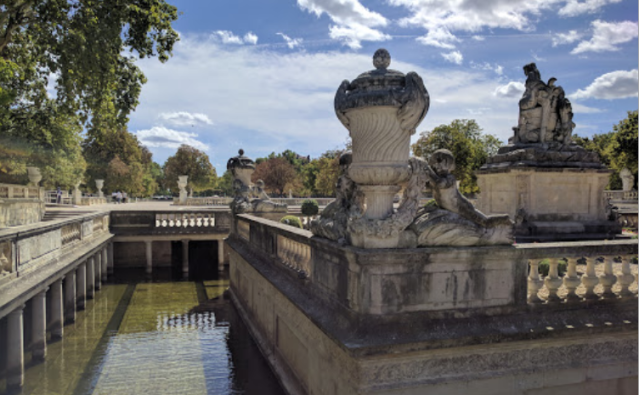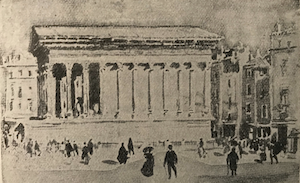
Section of the Jardin de la Fontaine, in Nîmes, as seen in 2017. (Attila Nemet)
Here is a passage from A Little Tour in France, by Henry James, published in 1884. In this passage he is in Nîmes, a town in Provence best known for the Maison Carrée, a survivor from Roman days that inspired Thomas Jefferson’s design for his capitol building, in Richmond, Virginia. Of the Maison Carrée, James writes that “[t]he first impression you receive from this delicate little building, as you stand before it, is that you have already seen it many times. Photographs, engravings, models, medals, have placed it definitely in your eye.” This may be what happened to Jefferson as well, who saw it about a century before James described it in his little book. (Chap. XXVIII)

Drawing by Joseph Pennell from A Little Tour in France, by Henry James
The passage below was inspired by some ruins in Nîmes, in a park today known as the Jardin de la Fontaine, not far from the Maison Carrée. He writes that “[h]ere are the same terraces and steps and balustrades, and a system of water-works less impressive, perhaps, but very ingenious and charming. The whole place is a mixture of old Rome and of the French eighteenth century; for the remains of the antique baths are in a measure incorporated in the modern fountains.” He then mentions the ruins of a little temple to Diana, and continues:
The remains are very fragmentary, but they serve to show that the place was lovely. I spent half an hour in it on a perfect Sunday morning (it is enclosed by a high grille, carefully tended, and has a warden of its own), and with the help of my imagination tried to reconstruct a little the aspect of things in the Gallo-Roman days. I do wrong, perhaps, to say that I tried; from a flight so deliberate I should have shrunk. But there was a certain contagion of antiquity in the air; and among the ruins of baths and temples, in the very spot where the aqueduct that crosses the Gardon in the wondrous manner I had seen discharged itself, the picture of a splendid paganism seemed vaguely to glow. Roman baths, – Roman baths; those words alone were a scene. Everything was changed: I was strolling in a jardin francais; the bosky slope of the Mont Cavalier (a very modest mountain), hanging over the place, is crowned with a shapeless tower, which is as likely to be of mediaeval as of antique origin; and yet, as I leaned on the parapet of one of the fountains, where a flight of curved steps (a hemicycle, as the French say) descended into a basin full of dark, cool recesses, where the slabs of the Roman foundations gleam through the clear green water, – as in this attitude I surrendered myself to contemplation and reverie, it seemed to me that I touched for a moment the ancient world.
The passage merely shows how classical architecture can inspire flights of fancy of a sort that one might not expect to have walking down between the rows of Miesian glass boxes of Park Avenue in New York City.

Temple of Diana ruin at Jardin de la Fontaine. (Monumentum)



To give you sense how debilitating architecture can be. Look no further than the military magnet school a public school in Charleston South Carolina. So contorted and sterile they used the outside of it’s alcatraz-esque facade for the psychiatric prison in the 2018 Horror Sequel, Halloween

https://i0.wp.com/globalfilmlocations.net/wp-content/uploads/2018/10/smiths-grove2.png?resize=928%2C543&ssl=1
This defunct JC Penney has more architectural charm.

LikeLike
Nimes is indeed a gem. I especially appreciated the drawing by Pennell, one of the great architectural renderers in the Golden Age of architectural renderings, of the Maison Carree, showing the handsome surrounding vernacular buildings. Alas, these background buildings are gone now, replaced by some garish and unsightly “famous” modernist intervention. An unaccountable desecration.
LikeLike
Actually, you’re entirely wrong about the “vernacular buildings” that appear behind the Maison Carrée in the Pennell drawing being gone: https://www.dreamstime.com/sunset-maison-carree-nimes-france-maison-carree-nimes-france-image118078634. The Norman Foster-designed “Carré d’Art” is on the other side of the square and not at all visible from Pennell’s vantage point.
LikeLike
I enjoy your writing and James’.
You have inspired a trip to Nimes. Thanks
LikeLike
Thank you very much, Ed.
Can I come? … 😉
LikeLike